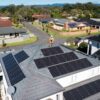
The Space Information Sharing and Analysis Center (Space ISAC) issued a TLP: CLEAR public update on its threat level assessment. The release aims to raise awareness among the space industry, government agencies, and international partners about the current threat landscape. Increased targeting, proliferation of hacktivism and geopolitically motivated attacks, and social engineering TTPs increase efficacy of initial access were among some of the factors that are commensurate with the specified criteria for Level 3: High.
The space threat landscape remains active, characterized by disruptive cyber activity and electronic warfare (EW). These factors are exacerbated by geopolitical conflicts in the Middle East, and reports from government agencies and commercial firms reaffirm this sentiment, while warning that low-level attacks may soon rise to sophisticated attacks. Additionally, the heightened frequency and impact of GNSS interference, jamming, and spoofing continue to pose concerns to satellite operators, reflecting a robust threat environment.
Space ISAC identified that this decision is informed by input from the organization’s diverse members and partners, including those from commercial, international, defense, intelligence community, and collective intelligence sectors. Also, analysts identified several factors contributing to the heightened threat environment within space and related sectors.
Cyber threat actors have recently increased attacks on organizations operating in the space sector and related industries, often in response to ongoing geopolitical conflicts. Global conflicts are driving both new and existing threat groups to focus on organizations with ties to national security, including government, defense, and space entities.
Threat groups are also using as-a-service toolkits and other social engineering tactics to bypass firewalls, content filters, and human threat detection, increasing the effectiveness of their initial access efforts.
Interference with Global Navigation Satellite Systems (GNSS) frequently coincides with geopolitical events, disrupting user segments and affecting the availability of satellite services. Additionally, space environmental events pose further risks to operators, including space debris generated by on-orbit breakups and the effects of solar storms on space weather conditions.
Additional factors contributing to this determination include the advanced techniques that threat actors are employing in both financially motivated and espionage-based attacks. The growing presence of initial access brokers blurs these lines and supports future attacks for more sophisticated threats.
Space ISAC said that it will continue to closely monitor these developments and adjust the threat level as warranted based on changes in the operational environment and reporting from partners and members.
Members should evaluate account and credential access to identify and address potential weaknesses. They should implement routine scans to detect malicious network traffic and ensure regular reviews and patch management for all critical systems. It is important to report any incidents, vulnerabilities, or threats to the Space ISAC and other appropriate authorities. Additionally, members should communicate threat-related information clearly and promptly to internal staff.
Furthermore, Space ISAC encourages members to stay informed and proactive in mitigating potential threats to ensure the resilience of space systems and infrastructure.
In April, the Space ISAC launched its UK Global Hub, a major advancement in its mission to foster international collaboration in space security. The expansion enhances Space ISAC’s growing capabilities by strengthening real-time monitoring of cyber and physical threats impacting space systems. Additionally, it also improves global response times to emerging space security threats through a more strategic incident response coordination.

Anna Ribeiro
Industrial Cyber News Editor. Anna Ribeiro is a freelance journalist with over 14 years of experience in the areas of security, data storage, virtualization and IoT.




